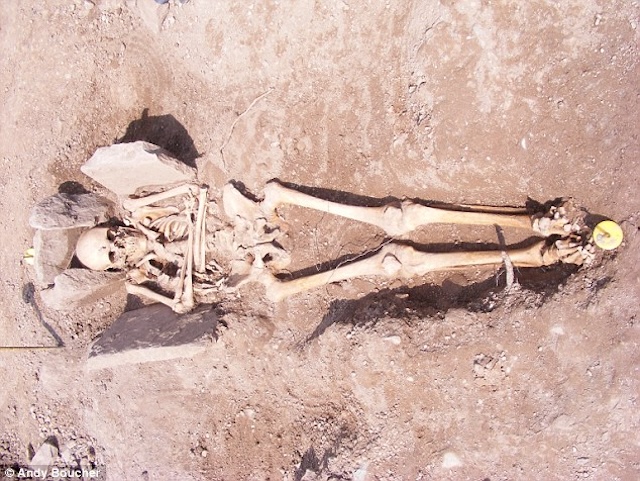The recent discovery of a 12th-century skeleton at Hereford Cathedral has captivated the attention of historians and archaeologists alike. Believed to be the remains of a medieval knight, this finding offers an extraordinary opportunity to delve into the perilous and often brutal world of jousting—a sport deeply intertwined with the chivalric code of the Middle Ages. The evidence preserved in this individual’s bones paints a vivid picture of the challenges and dangers that defined a knight’s life, shaped by the demands of combat and the pursuit of glory.

Evidence of a Dangerous Existence
Detailed analysis of the skeleton reveals significant injuries, particularly fractures in the ribs and shoulder area. These wounds align closely with those commonly sustained during jousting or combat training. Jousting, often celebrated as a demonstration of skill and valor, was far from the romanticized image of knights in shining armor. It was a grueling and hazardous endeavor where participants risked severe injury—or even death—to achieve prestige and honor. The damage observed in this skeleton suggests that this knight endured the rigors of numerous tournaments or relentless training sessions aimed at mastering martial skills.
The severity of the injuries also raises questions about the circumstances surrounding his death. While the exact cause remains uncertain, it is possible that the accumulated trauma played a significant role in his demise. This poignant reminder of the sacrifices made in the name of honor and status underscores the harsh realities of life as a medieval knight.
The Importance of Hereford Cathedral
Adding another layer of intrigue to this discovery is the burial site itself. Hereford Cathedral, renowned for its historical and religious significance, was often reserved as a final resting place for individuals of high social standing. The knight’s burial within such a revered location suggests that he held a prominent position in medieval society. He may have been a landowner, a loyal servant to a noble house, or a respected warrior whose contributions earned him a place of honor. This association with Hereford Cathedral elevates the significance of the find, offering a deeper understanding of the social hierarchies and cultural values of the time.
Jousting: A Cultural Phenomenon
Jousting was far more than a mere martial exercise; it was a defining element of medieval culture. These tournaments were elaborate spectacles that showcased the ideals of chivalry, bravery, and physical prowess. Beyond their entertainment value, jousting events provided knights with opportunities to gain recognition, form strategic alliances, and demonstrate unwavering loyalty to their lords. They served as both a stage for individual achievement and a reflection of the broader societal values of the medieval world.
However, this discovery highlights the darker aspects of jousting. Beneath the grandeur and pageantry lay the very real dangers faced by knights who participated in these events. The pursuit of glory often came at a steep cost, as evidenced by the injuries etched into this knight’s skeleton.
Insights Gained from the Discovery
This remarkable find offers invaluable insights into the lives of medieval knights. It provides a tangible connection to the physical toll exacted by their profession and reveals the central role that tournaments played in medieval culture. The skeleton challenges modern perceptions of the Middle Ages, moving beyond the romanticized image of gallant warriors to uncover the complex realities of their existence.
Additionally, the discovery raises compelling questions about the evolution of combat sports and societal values. What drove medieval knights to risk life and limb in pursuit of honor? How did they perceive concepts such as sacrifice and loyalty? These questions remain relevant as researchers continue to piece together the life of this remarkable individual.
A Legacy Unearthed
The story of this medieval knight transcends time, bridging centuries to connect us with an era defined by chivalry, honor, and bravery. His skeleton serves as a testament to the enduring human spirit—the drive to strive for excellence, even in the face of immense risk. This discovery not only enriches our understanding of the medieval period but also provides valuable insights into the cultural and personal motivations that shaped the lives of knights.
As further studies are conducted, the knight’s story will undoubtedly contribute to a broader understanding of medieval society. It sheds light on the sacrifices and achievements of individuals who lived and fought for ideals that continue to captivate the imagination today. Through this remarkable find, we gain a deeper appreciation for the resilience, ambition, and courage that defined the medieval era.
By examining the life and injuries of this 12th-century knight, we are reminded of the physical and psychological demands placed on individuals who pursued martial excellence. Their struggles and triumphs, immortalized in their bones, reveal a world where bravery and loyalty were not mere ideals but essential aspects of survival and identity. This discovery offers a window into a bygone era, challenging us to consider the enduring themes of sacrifice, honor, and the relentless pursuit of greatness. Through the lens of history, we are able to reflect on the complexities of human ambition and the universal drive to leave a lasting legacy.





